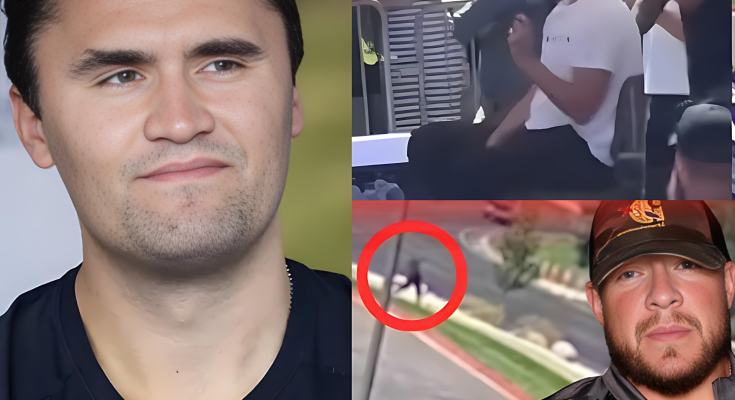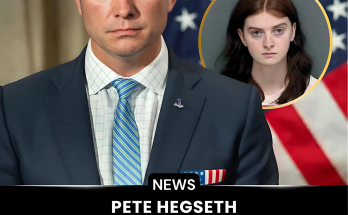Experts Rewind the Footage: Something Unusual Appears Behind Charlie Kirk — Enhanced Images Leave Viewers More Confused the More They Watch.
It started as a perfectly ordinary afternoon. The lights were bright, the cameras were rolling, and the room buzzed with that familiar energy that always followed a Charlie Kirk appearance. To those in the audience, nothing seemed out of the ordinary — a crowd of supporters, journalists scribbling notes, and the predictable rhythm of applause between sentences.
But several days later, when a small team of digital analysts began reviewing the footage for a university research project, something unexpected caught their attention. It wasn’t part of Kirk’s speech, nor was it anything he did. It was something — or someone — in the background. A movement so subtle that almost everyone watching it live had completely missed it.
:max_bytes(150000):strip_icc():focal(710x425:712x427)/charlie-kirk-091125-e1338d517c7244d8b49a66ba182adf3f.jpg)
The Moment That Sparked Curiosity
The analysts described it as a “faint shift in the frame.” It happened just as Kirk turned his head toward the left side of the stage — a barely noticeable blur behind him, like a shadow flickering for less than a second.
At first, they assumed it was a camera glitch or a compression artifact. After all, most recordings contain visual noise — lens reflections, autofocus shifts, or even shadows cast by moving lights. But this one was different. When slowed down to one-quarter speed, the movement appeared deliberate, synchronized, and oddly timed.
“Everything else in the frame stayed perfectly still,” said one of the technicians who examined the footage. “Only that small area changed, and the timing of it made us stop and replay the clip several times.”
What began as a routine review suddenly turned into a slow, frame-by-frame dissection of a single moment that no one had ever noticed before.

The Enhanced Footage
To understand what they were seeing, the team enhanced the video using standard contrast and color correction tools. When they brightened the darker regions of the frame, the faint blur turned into a defined shape — though still unclear enough to prevent conclusions.
The enhanced version didn’t reveal any hidden figure or object. Instead, it raised more questions. The “shape” appeared for less than two frames — roughly one-twelfth of a second — then vanished completely.
Some observers said it looked like a simple reflection. Others noticed that the movement seemed to align perfectly with a reaction in the audience — a brief shift of heads, a murmur, and one camera operator slightly repositioning his lens.
None of it proved anything unusual. But the fact that it appeared so precisely during Kirk’s turn toward that direction made the moment stand out.
When the Internet Got Involved
Once the enhanced footage made its way online, the story took on a life of its own. Forums filled with speculation. Some viewers claimed it was nothing more than light bouncing off a glass surface. Others began constructing elaborate theories about what the blur could represent.
The debate quickly divided online spaces. One group focused on technical explanations — lighting inconsistencies, sensor calibration, or a lens flare. Another group, however, treated the clip like a riddle that needed solving.
Hashtags began trending within hours:
#RewindTheFrame, #KirkEventMystery, and #TheBackgroundShift.
Each replay, each slowed-down version of the footage, seemed to fuel the mystery even more. People began marking timestamps, comparing angles, and overlaying the original broadcast with audience-shot clips to spot differences.

Chapter Four: The Analysts Speak
The original team that discovered the anomaly tried to calm things down.
In an interview, one of the researchers explained, “It’s easy to over-interpret things when you enhance a low-resolution video. Every small pixel shift can look intentional when viewed in isolation. But our job isn’t to speculate — it’s to observe patterns.”
Still, the team couldn’t deny how precisely the anomaly occurred: exactly as Kirk paused mid-sentence.
That detail — the synchronization — became the focus of new analysis. Video editors, photographers, and even sound engineers joined in. One editor from Los Angeles commented, “The strangest part isn’t the blur itself. It’s how the rest of the image remains completely static, even though the lighting should have caused more visual noise if it was just a reflection.”
The debate evolved from curiosity to technical fascination.
The Psychology of Perception
By the second week, the “Charlie Kirk Frame” had become a case study in digital perception. Psychologists who study visual illusions joined the conversation, offering a different kind of explanation.
According to Dr. Melissa Hampton, a cognitive researcher from Boston University, what people were seeing might not have been in the footage at all — but in their minds.
“When you tell someone that there’s something hidden in a video,” she said, “their brain becomes hyper-alert. They start detecting patterns that may not actually exist. This phenomenon is calledapophenia — the tendency to perceive meaningful images or patterns in random data.”
Her statement brought balance to the conversation. Maybe the footage wasn’t hiding anything. Maybe the mystery was in the viewers’ perception itself.

Frame by Frame
Still, thousands of people continued dissecting every millisecond.
Some YouTube creators uploaded slowed versions with commentary, comparing different color filters. Others tested the footage using AI motion analysis tools.
A few of these tools even generated visual outlines — suggesting faint geometric patterns that might have been camera artifacts. Yet, because the footage was recorded under fluorescent light, small oscillations in brightness could easily create those illusions.
Despite these rational explanations, one thing remained consistent: the fascination. Every person who watched it seemed drawn in, replaying the same two seconds again and again.
“It’s almost hypnotic,” one commenter wrote. “You can’t stop watching because you keep thinking you’ll notice something new.”
When Curiosity Turns Collective
By the third week, the discussion had evolved into something larger — not about what the footage showed, but about how people reacted to it. Sociologists began calling itcollective curiosity syndrome: when a large group of people fixates on a single ambiguous event that feels like it hides meaning.
This isn’t new. History is full of similar moments — optical illusions, unexplained photos, or short video clips that generate endless online theories. But what made this case different was how ordinary it was.
There was no scandal, no dramatic event — just a public speech, a brief blur, and a crowd of people determined to make sense of it.
In many ways, it became a mirror reflecting how the internet amplifies curiosity itself.
The Search for “Truth”
Several independent analysts attempted to reconstruct the event from multiple angles. Some contacted the venue to request lighting setup details. Others examined the metadata of the original recording to check for frame drops or compression artifacts.
The results were inconclusive.
One team found minor inconsistencies in how the footage was encoded, possibly due to a secondary camera feed merging mid-recording. That would explain why one frame looked slightly misaligned — creating the illusion of motion behind Kirk.
But even after publishing their findings, the debate refused to die down. The human mind, after all, doesn’t crave certainty as much as it craves mystery.
The Emotional Hook
What truly kept people watching wasn’t the technical explanation — it was the feeling.
The video had a rhythm to it: the speaker pausing, the crowd waiting, the flicker in the background. It gave a sense that something had been overlooked, something right there in plain sight.
That emotional tension — the maybe — kept the clip alive in the algorithm. Each new viewer added another layer of interpretation, often projecting their own beliefs or curiosities onto it.
Psychologists note that this is how modern mysteries survive online. They don’t need definitive proof — they just need endless possibilities.

The Media’s Response
Mainstream outlets eventually caught wind of the viral clip. A few ran short explainers under headlines like “The Charlie Kirk Video Everyone Is Talking About” or “The Blink-and-You’ll-Miss-It Moment That Sparked a Debate.”
Most coverage focused not on Kirk himself, but on how a tiny anomaly could ignite such massive attention. It became a discussion about how technology changes perception — how enhancement tools, replay features, and online forums turn simple clips into national talking points.
“It’s a perfect example of the age we live in,” said digital culture analyst Jason Lee. “We don’t watch events anymore; we reconstruct them.”
Behind the Screens
The enhanced footage continued circulating for weeks, drawing millions of views. But in the background, something more interesting was happening: communities were forming.
People who had never met before started collaborating, comparing data, and sharing theories respectfully — a rare thing in online debates. For many, the process of searching together became more meaningful than finding an answer.
In interviews, several users described how the clip had inspired them to learn about video editing, color correction, or even cognitive science. A small mystery had become a gateway to education.
That’s perhaps the most surprising twist of all — the way curiosity, when handled responsibly, can turn confusion into creativity.
Rewatching Reality
Months later, the clip still resurfaces occasionally. Sometimes it appears in media literacy discussions, other times in college courses exploring visual analysis.
Educators use it to teach a simple but powerful lesson:
seeing is not always understanding.
Every video, every frame, every pause we analyze tells more about how we interpret information than about the footage itself.
In the case of the Charlie Kirk recording, the mystery wasn’t hidden behind him. It was hidden within us — in the way our brains process uncertainty, and our desire to uncover meaning even when none may exist.
The Philosophy of the Frame
Philosophers have long argued that human beings are pattern-seeking creatures. We search for signals in noise because it gives us a sense of control. In digital culture, that instinct has evolved — we zoom, enhance, slow down, and isolate fragments of reality to feel closer to “truth.”
But the more we analyze, the more elusive that truth becomes.
This is what made the “Charlie Kirk frame” such a phenomenon. It wasn’t about politics or personalities — it was about our collective obsession with the unknown.
In the past, mysteries required physical evidence. Now, a single pixel shift can spark global discussion.
Lessons from the Blur
Eventually, the original analysts who discovered the anomaly released a full technical report. Their conclusion?
The blur was likely caused by a brief reflection off a moving object — possibly a photographer’s camera strap catching the light.
Simple. Ordinary. Unremarkable.
But the world didn’t treat it that way. And that’s what makes the story powerful. The meaning we give to uncertainty often matters more than the facts that resolve it.
The analysts’ final note read:
“Our fascination with the unexplained says more about us than about the footage itself.”
Beyond the Clip
Today, months after the footage first went viral, most people have moved on. But for those who followed the mystery closely, it left a lasting impression — not because of what they saw, but because of how they saw it.
It reminded viewers that digital truth is fragile. A single frame can mean a thousand different things, depending on who’s watching and what they expect to find.
And in a world of endless playback and analysis, maybe that’s the point — not to find absolute answers, but to keep asking better questions.
The Power of Observation
The story of the “Charlie Kirk Frame” isn’t about exposure, secrets, or revelations. It’s about the human need to make sense of moments that don’t immediately fit into logic.
It began as a glitch. It became a mystery. And in the end, it turned into a reflection — of technology, perception, and the digital age’s endless hunger for meaning.
When viewers slow down the footage today, what they really discover isn’t what’s behind Charlie Kirk…
It’s what’s inside themselves — the part that keeps looking, even when there’s nothing left to find.
THE ROOM WENT DEAD SILENT — AFTER JEANINE PIRRO HEARD THE “SENSITIVE TRUTH” ABOUT BRITTNEY GRINER’S GENDER.

THE ROOM WENT DEAD SILENT — AFTER JEANINE PIRRO HEARD THE “SENSITIVE TRUTH” ABOUT BRITTNEY GRINER’S GENDER.
She didn’t scream. She didn’t curse. But the way Jeanine Pirro delivered her words — slow, cold, and razor-sharp — was enough to make the cameras freeze, the anchor flinch, and the director cut the feed on live television.
The show wasn’t supposed to go there. The topic was already pushing limits — gender, fairness, sports. Fox News had packaged it as a “special debate,” but anyone familiar with the panel knew the fire was waiting to start. And Jeanine Pirro was the match.



